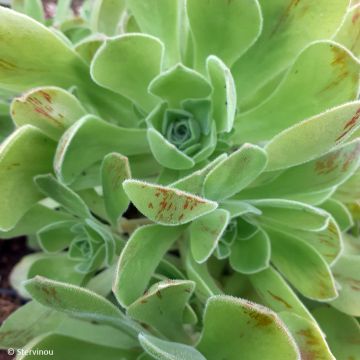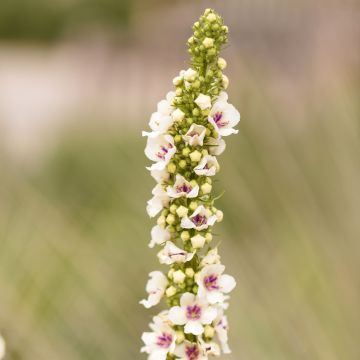

Aeonium arboreum Kilimandjaro - Tree Houseleek
Aeonium arboreum Kilimandjaro - Tree Houseleek
Aeonium arboreum Kilimandjaro
Tree Houseleek, Irish Rose
Special offer!
Receive a €20 voucher for any order over €90 (excluding delivery costs, credit notes, and plastic-free options)!
1- Add your favorite plants to your cart.
2- Once you have reached €90, confirm your order (you can even choose the delivery date!).
3- As soon as your order is shipped, you will receive an email containing your voucher code, valid for 3 months (90 days).
Your voucher is unique and can only be used once, for any order with a minimum value of €20, excluding delivery costs.
Can be combined with other current offers, non-divisible and non-refundable.
Home or relay delivery (depending on size and destination)
Schedule delivery date,
and select date in basket
This plant carries a 24 months recovery warranty
More information
We guarantee the quality of our plants for a full growing cycle, and will replace at our expense any plant that fails to recover under normal climatic and planting conditions.
Would this plant suit my garden?
Set up your Plantfit profile →
Description
The Aeonium arboreum 'Kilimanjaro' is a Chinese horticultural hybrid with extremely decorative foliage. Very compact and therefore perfectly suited for pot culture, it forms a small tuft a little wider than high, made up of numerous terminal rosettes carried on short axes. Their purple colour on the periphery turns green towards the centre, while a median streak stretches from the base to the tip in colours ranging from cream to red. In spring, the plant is adorned with clusters of small yellow flowers, beautifully complemented by the dark foliage. Frost-sensitive, it should be overwintered practically everywhere in France, or protected in milder climates.
Aeonium is a succulent plant of the Crassulaceae family, which includes 30 genera and nearly 1400 species, widely used for ornamental purposes, such as the famous exotic Kalanchoe, so common in our interiors. The Houseleek (Sempervivum), on the other hand, is part of our native flora, while also presenting great ornamental qualities.
There are 45 Aeonium species, all sharing a family resemblance, most of which are native to the Canary Islands. The hybrid 'Kilimanjaro' is a Chinese creation that appeared on the market before 2020. According to some sources, this cultivar will be derived from the 'Medusa' variety itself descended from the 'Velour' Aeonium, but other specialists question this lineage. Nevertheless, this variety immediately captivated with the beauty and originality of its foliage, as well as its compactness. This small Aeonium does not exceed 40 to 50 cm in height and 30 to 40 cm in width, making it an ideal subject for container planting. Resistant only to light frosts, it should be sheltered during winter and can only be planted in the most protected areas of the French Riviera. Like other varieties, it forms perfectly geometric rosettes, arranged at the ends of the short shoots in Kilimanjaro, giving a practically pyramidal silhouette. Tightly packed together, the rosettes of varying diameters intermingle in a skillful disorder that adds charm to the plant. The succulent leaves are spatulate and mucronate: narrow at their attachment to the branch, they widen to reach their maximum width near the opposite end before abruptly rounding and ending in a very slight point. The young leaves that form from the centre are tiny and arranged 360°, enlarging as they move away, forming a rosette of approximately 6 to 10 cm in diameter. The centre is green, then turns increasingly purple on the outer concentric circles. Starting from the base to the tip of the leaf, a striated margin stretches along the entire length, transitioning from a cream yellow in the centre that contrasts with the green, to a red that stands out on the purple periphery. In winter, the colours are slightly less intense and regain vigour in the summer sun. It is particularly interesting to position the plant so that the rising sun rays can shine through its foliage, creating absolutely stunning transparency effects.
Adult plants also produce a very attractive flowering in the form of pyramidal clusters, composed of small starry yellow flowers. Carried on short floral stems, they bloom from April to June, creating a strong contrast with the darker foliage.
Well adapted to drought once sufficiently rooted, Aeonium is the epitome of an easy plant that won't risk dying during your summer holidays. Its very poor hardiness requires it to be grown in pots almost everywhere, which it generally tolerates well, and even more so this compact 'Kilimanjaro' hybrid. It will adorn your terrace while you shelter it in a frost-free and bright location during winter to best preserve its beautiful colours, which fade if lacking sunlight. You can create an exotic setting by pairing it with other tender plants with distinctive looks such as the Aloe vera, both decorative and useful, as its sap applied to the skin immediately soothes burns. A bit hardier, the Agapanthus 'Charlotte' forms a magnificent potted display with starry light blue flowers veined with dark, which have the good taste to bloom from June to September. This beautiful exotic perennial will bring joy to your plant scene.
Plant habit
Flowering
Foliage
Botanical data
Aeonium
arboreum
Kilimandjaro
Crassulaceae
Tree Houseleek, Irish Rose
Cultivar or hybrid
Other Aeonium
View all →Planting and care
The Aeonium 'Kilimanjaro', very heat and drought resistant, requires a light, perfectly drained, sandy, poor, even slightly chalky soil. Plant it in spring in the ground in a mild, warm and dry climate, and in a very sheltered location. Planting in pots is possible all year round, sheltered from frost of course. It thrives in the sun or partial shade south of the Loire, and likes to have its roots warm. Its hardiness is very low, it tolerates occasional 0°C which greatly limits the possibilities of planting in the ground. Overwinter this young plant in an unheated but frost-free and absolutely bright place, otherwise its colours will noticeably fade. Water moderately from autumn to spring, and sparingly in summer. Remove faded inflorescences and dead branches.
Planting period
Intended location
Care
Planting & care advice
This item has not been reviewed yet - be the first to leave a review about it.
Similar products
Haven't found what you were looking for?
Hardiness is the lowest winter temperature a plant can endure without suffering serious damage or even dying. However, hardiness is affected by location (a sheltered area, such as a patio), protection (winter cover) and soil type (hardiness is improved by well-drained soil).

Photo Sharing Terms & Conditions
In order to encourage gardeners to interact and share their experiences, Promesse de fleurs offers various media enabling content to be uploaded onto its Site - in particular via the ‘Photo sharing’ module.
The User agrees to refrain from:
- Posting any content that is illegal, prejudicial, insulting, racist, inciteful to hatred, revisionist, contrary to public decency, that infringes on privacy or on the privacy rights of third parties, in particular the publicity rights of persons and goods, intellectual property rights, or the right to privacy.
- Submitting content on behalf of a third party;
- Impersonate the identity of a third party and/or publish any personal information about a third party;
In general, the User undertakes to refrain from any unethical behaviour.
All Content (in particular text, comments, files, images, photos, videos, creative works, etc.), which may be subject to property or intellectual property rights, image or other private rights, shall remain the property of the User, subject to the limited rights granted by the terms of the licence granted by Promesse de fleurs as stated below. Users are at liberty to publish or not to publish such Content on the Site, notably via the ‘Photo Sharing’ facility, and accept that this Content shall be made public and freely accessible, notably on the Internet.
Users further acknowledge, undertake to have ,and guarantee that they hold all necessary rights and permissions to publish such material on the Site, in particular with regard to the legislation in force pertaining to any privacy, property, intellectual property, image, or contractual rights, or rights of any other nature. By publishing such Content on the Site, Users acknowledge accepting full liability as publishers of the Content within the meaning of the law, and grant Promesse de fleurs, free of charge, an inclusive, worldwide licence for the said Content for the entire duration of its publication, including all reproduction, representation, up/downloading, displaying, performing, transmission, and storage rights.
Users also grant permission for their name to be linked to the Content and accept that this link may not always be made available.
By engaging in posting material, Users consent to their Content becoming automatically accessible on the Internet, in particular on other sites and/or blogs and/or web pages of the Promesse de fleurs site, including in particular social pages and the Promesse de fleurs catalogue.
Users may secure the removal of entrusted content free of charge by issuing a simple request via our contact form.
The flowering period indicated on our website applies to countries and regions located in USDA zone 8 (France, the United Kingdom, Ireland, the Netherlands, etc.)
It will vary according to where you live:
- In zones 9 to 10 (Italy, Spain, Greece, etc.), flowering will occur about 2 to 4 weeks earlier.
- In zones 6 to 7 (Germany, Poland, Slovenia, and lower mountainous regions), flowering will be delayed by 2 to 3 weeks.
- In zone 5 (Central Europe, Scandinavia), blooming will be delayed by 3 to 5 weeks.
In temperate climates, pruning of spring-flowering shrubs (forsythia, spireas, etc.) should be done just after flowering.
Pruning of summer-flowering shrubs (Indian Lilac, Perovskia, etc.) can be done in winter or spring.
In cold regions as well as with frost-sensitive plants, avoid pruning too early when severe frosts may still occur.
The planting period indicated on our website applies to countries and regions located in USDA zone 8 (France, United Kingdom, Ireland, Netherlands).
It will vary according to where you live:
- In Mediterranean zones (Marseille, Madrid, Milan, etc.), autumn and winter are the best planting periods.
- In continental zones (Strasbourg, Munich, Vienna, etc.), delay planting by 2 to 3 weeks in spring and bring it forward by 2 to 4 weeks in autumn.
- In mountainous regions (the Alps, Pyrenees, Carpathians, etc.), it is best to plant in late spring (May-June) or late summer (August-September).
The harvesting period indicated on our website applies to countries and regions in USDA zone 8 (France, England, Ireland, the Netherlands).
In colder areas (Scandinavia, Poland, Austria...) fruit and vegetable harvests are likely to be delayed by 3-4 weeks.
In warmer areas (Italy, Spain, Greece, etc.), harvesting will probably take place earlier, depending on weather conditions.
The sowing periods indicated on our website apply to countries and regions within USDA Zone 8 (France, UK, Ireland, Netherlands).
In colder areas (Scandinavia, Poland, Austria...), delay any outdoor sowing by 3-4 weeks, or sow under glass.
In warmer climes (Italy, Spain, Greece, etc.), bring outdoor sowing forward by a few weeks.



























































